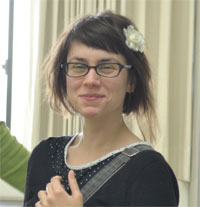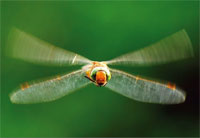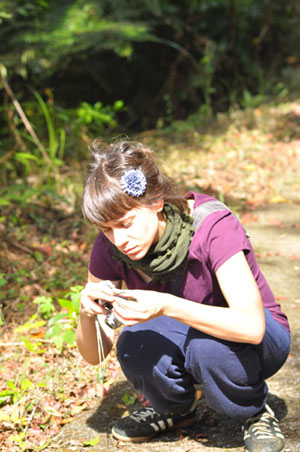本網站已搬家!
自 2014 年 3 月起,我們將網站遷移到新伺服器:http://web.ntnu.edu.tw/~treehopper/。本網頁內容已不再更新。請更新您的瀏覽器書籤亦或任何相關網址。
成員清單
目前成員
- 王若凡
- 1. 短腹幽蟌 Euphaea formosa 的領域行為. 2. 角蟬前胸背板的演化模式.
- 陳宏年
- 1. 颱風如何影響白痣珈蟌, Matrona cyanoptera 的存活率. 2. Euphaea amphicyana 表型變異模式.
- 葉人瑋
- 臺灣 Carabus 步行蟲生態與演化.
- 鄭筠潔
- 水蠆到底吃什麼?短腹幽蟌和白痣珈蟌稚蟲的DNA條碼食性分析.
- 黃崇鑫
- 雞冠細身鍬形蟲大顎對稱性與發育不穩定性.
- 曾惠芸
- 1. 球背象鼻蟲體色斑紋的功能. 2. 球背象鼻蟲親緣關係與體色斑紋的演化. 3. 蘭嶼與綠島球背象鼻蟲族群遺傳研究.
- 蕭伊廷
- Euphaea amphicyana 幽蟌生殖器變異.
- 陳彥廷
- 大雪山森林經營模式對鞍馬山步行蟲型態的影響.
- 黃均蕙
- 鹿角鍬形蟲的打鬥行為模式.
- 吳詩婷
- 角蟬.
- 林橋威
- 鹿角鍬形蟲的打鬥行為模式.
- 蘇詠超
- 行為生態、社會生物、族群遺傳、及分子親緣關係
歷屆成員
- 蕭瑋良
- Euphaea amphicyana 幽蟌翅脈地理變異.
- 翁麗紋
- 黃緣螢幼蟲為何發光?
- 李逸鴻
- Euphaea 屬豆娘種化模式.
- 關哲昀
- 雞冠細身鍬形蟲大顎變異.
- 鄭竹晏
- 菲律賓弧角蟬親緣地理.
- 陳明玉
- 菲律賓雅角蟬 Centrochares horifficus 的親緣地理與族群歷史.
- 黃紹彰
- 白痣珈蟌視覺溝通系統
- 黃仁磐
- 短腹幽蟌 Euphaea formosa 的族群遺傳與親緣地理分析
- 陳薇云
- 泡沫蟬 Okiscarta uchidae 內共生菌之分子特徵與親緣關係
訪問學者和學生
- Vanitha Williams
- 負子椿象和蜻蜓幼蟲對孓孓的補食潛力
- Marina Vilenica
- Klaas-Douwe 'KD' B. Dijkstra
- 蜻蛉歷史,多樣性,與鑑定
- Erin McCullough
- 武器的多樣性: 甲蟲的空氣動力損耗.
- Ashley E. King
- 獨角仙之性別內打鬥與性別間敵對行為.
Marina Vilenica

職稱
訪問學生, 克羅埃西亞 2010
研究物種:Dragonfly

研究主題
克羅埃西亞 Turopolje 地區溼地蜻蜓組成
摘要
Wetland habitats are the most threatened ecosystems due to water-drainage, excessive exploitation and pollution, which is why they are increasingly disappearing all around Europe. To maintain the high species richness, it is essential to maintain a variety of biotopes. Therefore, wetland area of Turopolje is an important habitat for biodiversity conservation in Croatia. In biodiversity conservation dragonflies serve as umbrella species representing specific biotic wetland assemblages. They are used as bio-indicators for freshwater ecosystems’ quality due to their sensitivity and complex food web. Literature data of the dragonfly findings on Croatian territory are relatively poorly represented. Also, dragonfly fauna in Turopolje area is very poorly researched. The primary objectives of this research were to determine dragonfly fauna and their distribution in Turopolje region. The survey was conducted from August 2007 until May 2009 at 9 localities. All investigated localities differ in their vegetation structure and amount of present water. Vegetation alliance for each locality was determined at a sight. For estimation of dragonfly composition per locality, Shannon-Weaver and Simpson index of diversity were used. 22 species with 307 specimens of dragonflies were determined, most of them belonging to the Libellulidae family. Only 1 species was recorded for families Lestide, Platycnemididae and Corduliidae. Species Calopteryx splendens (Harris, 1782), Coenagrion puella (Linnaeus, 1758) and Ischnura elegans (Vander Linden, 1820) were the most abundant species. On the other hand, species Pyrrhosoma nymphula (Sulzer, 1776), Lestes barbarus (Fabricius, 1798), Brachytron pratense (Müller, 1764), Epitheca bimaculata (Charpentier, 1825), Gomphus vulgatissimus (Linnaeus, 1758), Orthetrum cancellatum (Linnaeus, 1758) and Orthetrum coerulescens (Fabricius, 1798) were recorded only for 1 locality. Also, endangered and protected species Erythromma najas (Hansemann, 1823), Lestes barbarus (Zygoptera), Aeshna isoceles (Müller, 1767), Epitheca bimaculata and Otrhetrum coerulescens (Anisoptera) were recorded. Shannon-Weaver and Simpson index of diversity showed that vegetation structure is one of the main factors that affect the composition of the dragonfly communities. Future investigations should include the entire Turopolje region as well as dragonfly larvae and sheds sampling.

Marina 在南投蓮華池研究站。